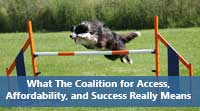 Last September a group of 80 colleges announced a new college application designed to improve access, affordability, and success. They actually call themselves the Coalition for Access, Affordability, and Success. But for some reason, the counselors who work with high school students, both private and school-based, don’t seem impressed with the new option. Maybe because the Coalition apparently hasn’t even piloted the application yet or listed any committed Community Based Organizations?
Last September a group of 80 colleges announced a new college application designed to improve access, affordability, and success. They actually call themselves the Coalition for Access, Affordability, and Success. But for some reason, the counselors who work with high school students, both private and school-based, don’t seem impressed with the new option. Maybe because the Coalition apparently hasn’t even piloted the application yet or listed any committed Community Based Organizations?
Despite the Coalition’s repeated claims that the application is designed to “level the playing field” for poor students and it really is a good thing, I just get a bad feeling whenever I think about it. There’s just too much about it that doesn’t make sense if it’s really about access, affordability, and success (see links below).
And then it dawned on me. This isn’t about access, affordability, and success for students. It’s about access, affordability, and success in admissions for the member institutions!
Now it makes sense.
I had problems coming up with what would be the selling points of the college application to counselors who work with under-represented students. But when I started to think about it in terms of benefiting members of the Coalition, it was pretty easy.
Just consider the potential advantages the application would have for the member colleges:
- Reduce the number of highly qualified students choosing to attend less prestigious schools that offer more merit money since such institutions won’t be part of the system.
- Members will have four years to train under-represented students to accumulate appropriate qualifications so that admission officers don’t really have to worry about diverse backgrounds.
- Target more students for early admissions based on locker status and zip codes’ median household income.
- Help flagship state universities attract more, higher-paying out-of-state applicants.
- Easier to identify under-represented students who will assimilate to college culture rather than actually change it. (Just think, they can cut back on the various “diversity” initiatives.)
- Create an accessible pool of applicants with greater financial resources since they probably paid for private counselors to help maintain their lockers.
- Good PR for helping poor students to access education without actually having to admit more poor students since there isn’t any assistance in providing computer resources to use the system or funding for mentors to guide students through the system.
- Potentially improve relationship with private counselors without having to acknowledge them since creating material for the lockers will increase their business. (Well, they certainly can’t expect a lot of good will from high school counselors.)
- Get to claim interested only in breaking the monopoly of the Common Application rather than abandoning a “diluted brand.”
- Concentrate shrinking demographic of traditional high school students in one place, improving brand awareness, while avoiding higher costs and uncertainty associated with outreach programs to historically under-represented groups.
The only drawback I see is what happens when the application crashes? No more Common Application to kick around, is there? But let’s face it, it doesn’t really matter. After all, given the group of colleges we’re talking about here, what are the students going to do besides complain?
Some more reading on The Coalition for Access, Affordability, and Success College Application
- Coalition of the Willing or the Wealthy?
- Prestige schools team up on redesigned college application
- The new college admissions coalition: Is it really about access?
- Admissions Revolution
- Jesuit High School College Counselors Association Letter
- A New Coalition of Elite Colleges Tries to Reshape Admissions
- Locked Out? What the New Coalition Application Means for College Admissions
- Elite Colleges Explore Alternative to Common App
- “Access” in Wonderland
If you’re interested in doing something about it, check out Counselors Against Needless Complexity in College Admission.


